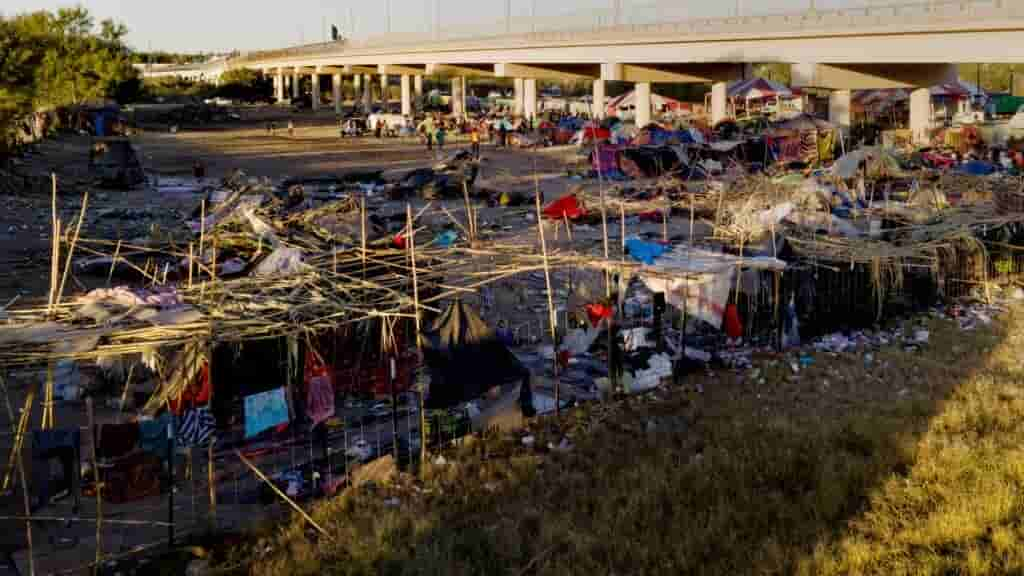One of the recent immigrations challenges the Biden administration faced was the tons of migrants who gathered and set up camps under the Del Rio International Bridge. This news provoked social media users to ask how Haitians ended up entering the U.S. through crossing into Texas rather than crossing into Florida which is closer to Haiti.
In a Facebook Post, one posted, “Am I the only one that wonders how 14,000 Haitians traveled 2,000 miles to end up under a bridge in Del Rio, Texas?” accompanied by a photo showing a straight red line from Haiti to the Caribbean Sea and the Gulf of Mexico to Texas.
The post was flagged due to Facebook’s efforts to prevent the spread of fake news and misinformation.
Here’s Why Migrants Enter U.S. Through Texas
Haitian migrants entering the U.S. border did not directly come from Haiti to Texas. They traveled from South Africa where they lived in previous years.
“That’s why they have ended up in Texas, not Florida. They are coming from South American countries, through Central America and Mexico, and ultimately to the U.S.-Mexico border,” said Jessica Bolter, a policy analyst at the nonpartisan Migration Policy Institute, Austin American-Statesman reported.
“They walk this route, as well as take buses and sometimes other forms of land transportation,” she added.

Current Migration Status Of Haiti Dates Back To 2010
In the past months, Haiti suffered a string of chaotic events such as the assassination of its president, tropical storms, and a massive earthquake. But these recent events are not entirely the reason why Haitians are leaving their country.
Back in 2010, a 7.0-magnitude earthquake hit the nation and damaged most parts of Port-au-Prince, Haiti’s capital. The massive earthquake killed an estimated 200,000 people and displaced more than 1.3 million.
Many Haitians then began traveling to South American countries like Chile and Brazil to look for jobs and a better living. The government of Brazil made humanitarian visas available to Haitians. There was also a major need for construction workers back then for the 2014 World Cup and the 2016 Olympics in Rio de Janeiro. But as soon as the job is done, most Haitians started moving to Chile, Bolter said.
From 2014 to 2018, over 150,000 Haitians went to Chile and worked as street vendors, janitors, and construction workers, according to an AP report. But in 2018, the government of Chile made it difficult for Haitians to have work visas.
“The cost of living in Chile is high, so it can be particularly difficult to get by with a poorly-paying job,” Bolter said, adding: “Many Haitians experience racial discrimination in jobs and housing in Chile as well. Haitians who stayed in Brazil have continued to struggle economically and have also faced racial discrimination, as well as crime and insecurity.”
Haitians Believe It Is Easier To Enter US Under Biden Administration
According to Bolter, when Joe Biden took office, many migrants thought that it would be easier to enter the U.S. compared to when Trump was the President. The migrants were encouraged to travel north.
“A lot of them came to Mexico with the hope of being able to live in Mexico,” said Jacqueline Charles, the Miami Herald’s Caribbean correspondent.
“But they’ve had a very difficult time getting work permits, finding jobs, even finding a place to live. And so this is a community that, you know, operates through word of mouth. So people started saying, hey, Ciudad Acuña is open. This port is open.”
Ciudad Acuña is a city in Mexico just across the Rio Grande from Del Rio. But, the port was not open and accessible to Haitians.
Earlier this year, Biden renewed the Temporary Protected Status for Haitians in the U.S. This status was withdrawn during the Trump administration. The status allows migrants to stay in the U.S. if their home country prevents them from returning safely.
But the Biden policy only applies to Haitians who are already living in the U.S. as of July 29, and not for those who are crossing the borders just now. And the number of illegal border crossings by Haitian migrants is at an all-time high, according to Bolter.
The U.S. Customs and Border Protection faced about 28,000 Haitian migrants crossing illegally through the southwestern border from October 2020 to August 2021. 24,000 of these crossed through Texas.
There are no data released for the month of September but according to news reports, over 15,000 migrants crossed to Del Rio. But they have already been either expelled or deported back to their countries.
Biden Administration Criticized For Haitian Migrants Handling
Most Haitian migrants are being expelled and deported under the Centers for Disease Control and Prevention’s Title 42 authority. A policy designed by former President Donald Trump to reduce the spread of the COVID-19 virus.
Some Democrats condemned the Biden administration for using Title 42 to expel Haitians. He is also being criticized after videos showing border agents mistreating Haitian migrants surfaced recently. Compilation of photos and videos circulated showing that agents riding in horses, pulling and hitting migrants.
Republicans also said that Biden failed to secure the U.S. border.


